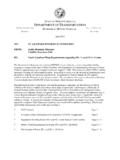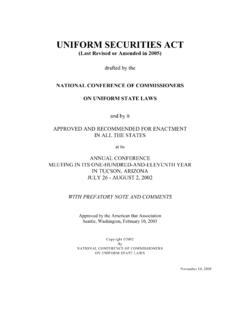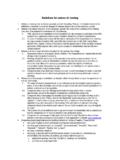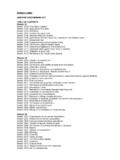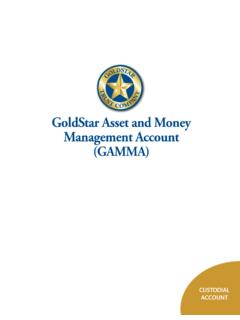Transcription of Financial Responsibility Programs - IICMVA
1 Financial Responsibility PROGRAMSAND PROCEDURES GUIDEOCTOBER, 1997 COMPILED BYINSURANCE INDUSTRY COMMITTEEONMOTOR VEHICLE ADMINISTRATION- 2 -The Insurance Industry Committee on Motor Vehicle Administration ( IICMVA ) consists ofrepresentatives from the three property/casualty trade associations, their affiliated membercompanies and independent companies. Its members write most of the motor vehicle andcommercial insurance in the United States. The IICMVA is not a lobbying organization nor is itinvolved in legislation. Its function is to be a liaison between the insurance industry and statemotor vehicle departments. The IICMVA advises and assists these agencies in theimplementation of laws such as those relating to Financial Responsibility , compulsory security,driver licensing and motor vehicle 5 - Financial Responsibility PROGRAMSAND PROCEDURES GUIDEINTRODUCTIONC ertification of liability insurance coverage for the future is a basic element in all financialresponsibility laws.
2 In order to reinstate a driving privilege after a driver license suspension, aninsurance company is called upon to certify liability coverage for the future, usually three years,for the affected individual. While the basic certification concept is for the most part ratheruniform among the states having Financial Responsibility laws, there are a number of Financial Responsibility Programs and Procedures guide, (formerly the Uniform FinancialResponsibility Forms Programs Administrative Procedures Guide) has been compiled by theInsurance Industry Committee on Motor Vehicle Administration ( IICMVA ) with the verysubstantial assistance of the motor vehicle department Financial Responsibility administrators ofthe Financial Responsibility laws are based on the original Uniform Vehicle Code, Chapter 7 - Financial Responsibility . While this chapter was deleted from the Code in 1971 by action of theNational Committee on Uniform Traffic Laws and Ordinances, it continues to be the basis for allfinancial Responsibility laws and is also found in most compulsory insurance laws.
3 This chapterwas updated and Financial Responsibility was put back into the UVC in proof of insurance is a critical feature in the enforcement of the sanctions contained infinancial Responsibility laws. When an insurer files certification of insurance with a state, it is, ineffect, guaranteeing liability coverage for the named individual for a specified period of act of certification creates a motor vehicle liability policy under which: The liability of the insurance carrier with respect to the insurance required by this chaptershall become absolute whenever injury or damage covered by said motor vehicle liabilitypolicy occurs; said policy may not be cancelled or annulled as to such liability by anyagreement between the insurance carrier and the insured after the occurrence of theinjury or damage; no statement made by the insured or on his behalf and no violation ofsaid policy shall defeat or void said policy.
4 Whenever an insurer files certification, it is on the risk until it files a cancellation notice with thestate. UVC Section 7-315 reads as follows: An insurer may not terminate a motor vehicle liability policy unless the insurer files withthe department a notice of termination within 10 days after the effective date oftermination. A motor vehicle liability policy subsequently procured shall on the effectivedate of its certification terminate the insurance previously certified. Failure by an insurer to file a cancellation notice, as required, can result in an indefiniteextension of the coverage so 6 -In order to administer the above quoted provisions of the Financial Responsibility law, standardprocedures and forms were developed many years ago for use by the states and insurers. TheProcedures Guide covers all types of future proof filings regardless of the forms terminologythat may be in effect in any given state.
5 It also highlights any individual state variations both asto forms and the most common certificate in use is the AAMVA Uniform Financial Responsibility FormSR22, there are two basic variations on the use of this form. The most commonly used is thespecified vehicle version in which one or more motor vehicles are described on the SR22. Theother approach is the so-called all-inclusive in which the form applies to all owned is also a semi-all-inclusive version which differs from the all-inclusive in that it certifiescoverage for all vehicles insured by the filing company as opposed to all vehicles owned by theindividual in the case of the all-inclusive filing. Another feature of the semi-all-inclusive forminvolves the cancellation notice requirements. It has a self-terminating clause whereby the filingautomatically terminates when the state s requirement ends in the given case.
6 A cancellationnotice is required only if the insurance is cancelled prior to that time. Further information isprovided in the sections dealing with specific most commonly used forms are the SR22 certificate and the SR26 termination notice. TheSR23 is used when a fleet risk is involved. The SR24 was originally designed to be a notice ofchange of motor vehicle. In recent years the use of the SR24 has almost disappeared. Whennotification of a change of vehicle is required by the state, a replacement SR22 is generallyutilized. In a few jurisdictions, a change of vehicle requires an SR26 and aspect of the program that has changed in recent years in most jurisdictions is theduplicate filing requirement wherein a copy of the form is returned to the filing insurer. Thisprocedure has been generally found to be superfluous. It adds to handling expense withoutserving any useful purpose.
7 This cumbersome procedure is gradually being replaced byelectronic transmission of , special note should be made of the situation in which an individual certified for futureproof in one state moves to another person needs a future proof Financial Responsibility certificate because of either an actual orpending driver license suspension. The suspension action is lifted upon receipt of thecertificate by the state agency and is re-imposed if the filing is terminated by the insurer duringthe filing requirement a person changes state of residence while a certificate is in effect, the insurer may terminatecoverage (termination is required if an automobile insurance plan policy (assigned risk) isinvolved or the company does not do business in the new state) when notified of the change ofaddress. This results in the reimposition of the driver license suspension. Depending on thestates involved, a new certificate may have to be filed in the old state, new state, both states orneither one.
8 When called upon to make a filing in a state other than the current residence statein which the policy is issued, an insurer, if it is continuing the policy in effect, should respondwith a filing in that state provided it is licensed to write automobile insurance in that state. Apolicy does not necessarily have to be written in the same state where a filing is 7 -In any specific instance of a filing problem involving an interstate change of residence, the FRadministrators in each state should be contacted to determine the appropriate handlingnecessary to resolve the 8 -The Procedures Guide contains for each state a separate complete description of the futureproof program. General instructions include preparation of forms, filing of forms and electronicfilings by insurers. Any special state variations are specifically 9 - Financial RESPONSIBILITYA Brief Overview Financial Responsibility is defined in Black s Law Dictionary, 5th edition, as a term commonlyused in connection with motor vehicle insurance equivalents.
9 (Emphasis added) The term equivalent is defined as equal in value, force, measure, volume, power, and effect or havingequal or corresponding import, meaning or significance; alike, identical. Financial Responsibility Acts as defined in Black s Law Dictionary, means state statuteswhich require owners of motor vehicles to produce proof of Financial accountability as acondition to acquiring a license and registration so that judgments rendered against themarising out of the operation of the vehicles may be satisfied. It is generally accepted, as a condition for operating on a state s (or the nation s) roadways, adriver has agreed to be financially responsible for any harm or damage caused through theoperation of his or her vehicle. A driver may comply with this duty by purchasing adequate motor vehicle insurance as defined by a minimum amount identified in a state s statute.
10 Adriver who fails to comply with this duty by not having insurance (or an adequate amount ofinsurance) or who has demonstrated a traffic safety and Financial accountability concern toother roadway users through some other action ( , accumulation of convictions and/oraccident involvement), may be required to satisfy a state s Financial Responsibility law in order tomaintain a driver are four circumstances which may require a driver to comply with a state s financialresponsibility laws in order to maintain a valid driver license:1. Unsatisfied JudgmentWhen a driver is involved in a motor vehicle crash for which he or she is determined to be atfault and for which the driver is either underinsured or uninsured, a court having jurisdictionover the matter may render a judgment to the other party (plaintiff) against the driver(defendant) for the cost of damages. The judgment against a driver will state the amount ofdamages (including in some cases interest), and specify the time period in which theamount must be paid.
